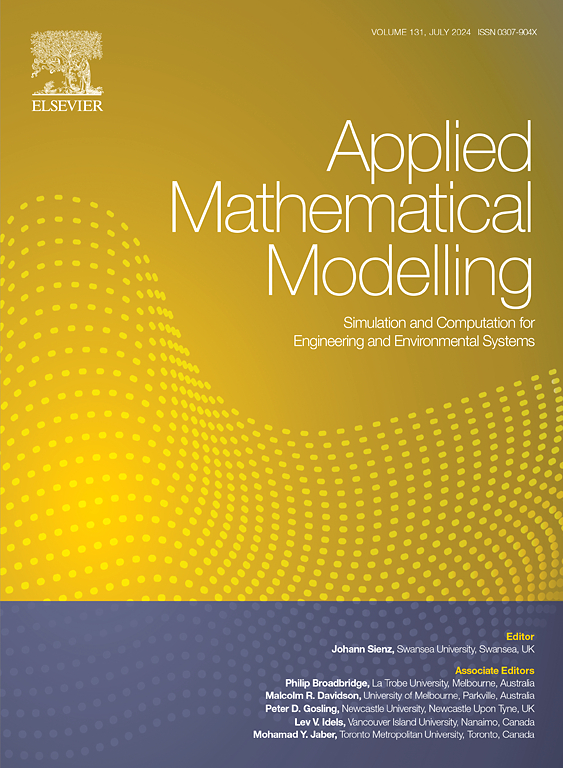一种通过叠加变形控制的二维平面层来构成三维空间壳体最优材料分布的逐层优化策略
IF 4.4
2区 工程技术
Q1 ENGINEERING, MULTIDISCIPLINARY
引用次数: 0
摘要
壳体的刚度最终受其材料分布的影响。为了在合理的计算成本下获得三维空间壳体的最优材料分布,本文提出了一种变形可控的逐层优化策略。该策略将三维空间壳体在厚度维度上划分为有限层,在匹配优化周期中,每一层的变形都受到预定目标体积的约束。在优化周期中,为了使计算成本最小化,我们使用降维水平集方法(DR-LSM),其中使用均匀初始设计在二维域中迭代三维空间壳体的最优二维平面层。将优化后的二维平面层依次堆叠,构建三维空间壳体的最优材料分布。数值计算和实验结果均表明,该策略在保留壳体原有几何特征的同时,成功地实现了三维空间壳体的最优材料分布,并消除了空腔结构。值得注意的是,在不改变壳体体积和质量的情况下,不同曲率壳体的刚度得到了显著提高,证明了该策略的稳定性和有效性。本文章由计算机程序翻译,如有差异,请以英文原文为准。
A layer-by-layer optimization strategy to constitute optimal material distribution of 3D spatial shells by stacking deformation-controlled 2D plain layers
The stiffness of a shell is conclusively influenced by the distribution of its material. To obtain the optimal material distribution of 3D spatial shells at a reasonable computational cost, this paper proposes a layer-by-layer optimization strategy with controllable deformation. In this strategy, the 3D spatial shell is divided into finite layers in the thickness dimension, and the deformations of each layer are constrained by the presupposed target volume in the matching optimization cycle. During the optimization cycle, to minimize the computational cost, we use a dimension-reduced level set method (DR-LSM), wherein the optimal 2D plane layers of the 3D spatial shell are iterated in the 2D domain using a uniform initial design. The optimized 2D plane layers are sequentially stacked to construct the optimal material distribution of the 3D spatial shell. Both numerical calculations and experimental results demonstrate that the proposed strategy successfully achieves an optimal material distribution for 3D spatial shells while preserving their original geometric characteristics and eliminating cavity structures. Notably, the stiffness of shells with different curvatures is significantly enhanced without altering its volume and mass, proving the stability and effectiveness of this strategy.
求助全文
通过发布文献求助,成功后即可免费获取论文全文。
去求助
来源期刊

Applied Mathematical Modelling
数学-工程:综合
CiteScore
9.80
自引率
8.00%
发文量
508
审稿时长
43 days
期刊介绍:
Applied Mathematical Modelling focuses on research related to the mathematical modelling of engineering and environmental processes, manufacturing, and industrial systems. A significant emerging area of research activity involves multiphysics processes, and contributions in this area are particularly encouraged.
This influential publication covers a wide spectrum of subjects including heat transfer, fluid mechanics, CFD, and transport phenomena; solid mechanics and mechanics of metals; electromagnets and MHD; reliability modelling and system optimization; finite volume, finite element, and boundary element procedures; modelling of inventory, industrial, manufacturing and logistics systems for viable decision making; civil engineering systems and structures; mineral and energy resources; relevant software engineering issues associated with CAD and CAE; and materials and metallurgical engineering.
Applied Mathematical Modelling is primarily interested in papers developing increased insights into real-world problems through novel mathematical modelling, novel applications or a combination of these. Papers employing existing numerical techniques must demonstrate sufficient novelty in the solution of practical problems. Papers on fuzzy logic in decision-making or purely financial mathematics are normally not considered. Research on fractional differential equations, bifurcation, and numerical methods needs to include practical examples. Population dynamics must solve realistic scenarios. Papers in the area of logistics and business modelling should demonstrate meaningful managerial insight. Submissions with no real-world application will not be considered.
 求助内容:
求助内容: 应助结果提醒方式:
应助结果提醒方式:


